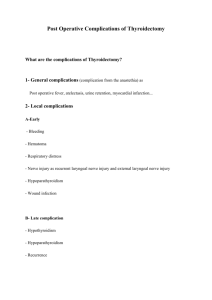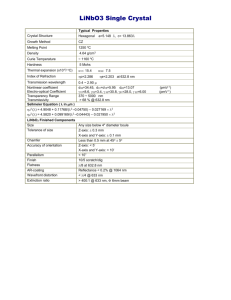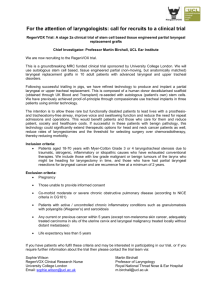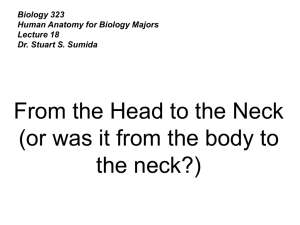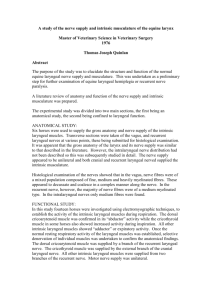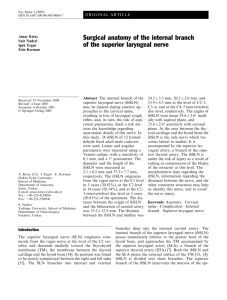Laryngeal Innervation
advertisement
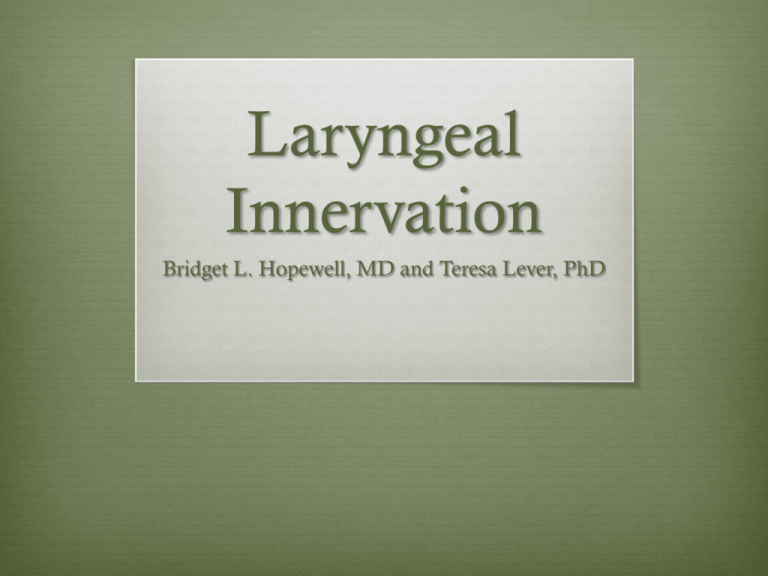
Laryngeal Innervation Bridget L. Hopewell, MD and Teresa Lever, PhD The nerve of Galli-Curci Celebrated opera soprano Underwent surgery in 1935 for a thyroid goiter- done under local to prevent injury The “amazing voice is gone forever; instead of cream velvet there is a sad quivering ghost” Many argue that SLN injury ended her career (though this is highly controversial) Laryngeal Anatomy Gbmc.org Laryngeal Anatomy 2 Gbmc.org Nysora.com Nerves to the larynx Recurrent laryngeal nerve Branch of vagus- arises at the level of the arch of aorta- travels up the side of the trachea to the larynx (left loops under the arch) Innervates all muscles except cricothyroid Sensation to larynx below vocal cords First documented by Galen Medscape.com Galen cut pigs’ recurrent laryngeal nerves while awake Pigs stopped squealing but continued to struggle and breathe. Recurrent Laryngeal Nerve Somatic fibers in the nucleus ambiguous and emerge from the medulla in the cranial root of the accessory nerve Fibers cross to join the vagus in the jugular foramen Sensory cell bodies are in the inferior jugular ganglion and fibers terminate in the solitary nucleus Parasympathetic fibers to segments of the trachea and esophagus in the neck originate in the dorsal nucleus of the vagus Pharyngeal Arches 1st – mandibular arch V2 and V3 Muscles of mastication, anterior belly of the digastric, mylohyoid, tensor tympani, tensor veli palatini Maxilla, mandible, incus, malleus, Meckel’s cartilage Maxillary artery, external carotid Pharyngeal Arches 2nd – hyoid arch Facial nerve Muscles of facial expression, buccinator, platysma, stapedius, stylohyoid, posterior belly of digastric Stapes, temporal styloid process, lesser horn and upper part of body of hyoid, Reichert’s cartilage Stapedial artery, hyoid artery 3rd Glossopharyngeal nerve Stylopharyngeus Greater horn and lower part of body of hyoid, thymus, inferior parathyroids Common Carotid, internal carotid Pharyngeal arches 4th superior laryngeal nerve cricothyroid muscle, intrinsic muscles of soft palate thyroid and epiglottic cartilage, superior parathyroids right- subclavian, left aortic arch 6th recurrent laryngeal nerve cricoid cartilage all intrinsic muscles of larynx except cricothyroid right pulmonary artery left pulmonary artery and ductus arteriosus RLN embryology RLN forms a loop around the sixth aortic arch On the left, the sixth arch forms the ductus arteriosus On the right, the sixth aortic arch disappears and the nerve loops around the more superior right subclavian artery Giraffes- 15feet RLN paralysis Injury to RLN resulting in temporary palsy of vocal cord reported at 0.2-5.8% of thyroidectomies Permanent paralysis 0.1-3.9% of cases Right RLN damaged more commonly because the left travels closer in the tracheo-esophageal groove (and non-recurrent inferior laryngeal nerves occur on right) Variation Extralaryngeal bifurcations or trifurcations of the terminal division of the nerve before it enters the larynx have been reported Anastomotic branches with sympathetic chain have also been reported Anatomic displacements, differing relationships to the inferior thyroid artery http://www.mevis-research.de/~hhj/Lunge/SammlungAna.html Non recurrent inferior Laryngeal nerve Less than 1% of surgical reports (1-2% in anatomic studies) Typically on the right, Associated with a right subclavian artery arising from the left side of the aorta usually crossing behind the trachea and esophagus. Non recurrent inferior laryngeal nerve Branches off the vagus May loop around inferior thyroid artery or come directly from vagus Left nonrecurrent 0.04%- situs inversus AND anomalous leftsided subclavian artery More variation… Nonlocalizing parathyroid adenoma Intrathyroidal RLN identified and dissected superiorly, a second nerve of equal size was encoutered origninating in the region of the right carotid sheath Merged with previously identified RLN to enter larynx Normal vascular anatomy Obaid T, Kulkarni N, Pezzi TA, Turkeltaub AE, Pezzi CM. Coexisting right nonrecurrent and right recurrent inferior laryngeal nerves: a rare and controversial entity : Report of a case and review of the literature. Surgery today. Nov 30 2013. No embryologic explanation Some argue it’s sympathetic fibers connecting into the RLN rather than concurrent NRILN If it’s sympathetic connection fibers their function is unclear Conclusion: all nerves that cross the space medial to the carotid sheath and travel toward the thyroid, trachea and larynx should be preserved RLN injury in horses Equine recurrent laryngeal neuropathy Appears to be disease of axons, high prevalence in thoroughbreds, more common in larger horses Left side nearly exclusively Presents with stertor- “roaring” and worsening performance Surgery Improve airway, breathing, performance (no voice concerns) Prosthetic Laryngoplasty “tie back” of arytenoid Ventriculectomy/Cordectomy Arytenoidectomy Only for failed tie-back or infected arytenoid Nerve graft Ortner’s Syndrome Cardiovocal syndrome Paralysis of left RLN due to cardiovascular disease Dilated LA from mitral valve stenosis, pulmonary htn, atrial myxoma, aortic anerysms 0.6%-5% in mitral valve stenosis Actually appears to be compression between the pulmonary artery, aorta, and left atrium (not by the dilated left atrium) Poor prognostic sign of heart disease Plastiras SC, Pamboucas C, Zafiriou T, Lazaris N, Toumanidis S. Ortner's syndrome: a multifactorial cardiovocal syndrome. Clinical cardiology. Jun 2010;33(6):E99-100. Superior Laryngeal Nerve Arises from nodose ganglion of vagus Crosses anterior to the cervical sympathetic chain, posterior to the internal carotid Receives a branch from the superior cervical sympathetic ganglion that contributes to the innervation of the carotid body and thyroid gland- at least 21 variations in this anatomy Divides into internal and external branches at a variable distance (0-20mm from origin) usually within bifurcation of the carotid Exit carotid sheath 20mm inferior to the bifurcation of the carotid Superior Laryngeal Nerve External branch of SLN lies immediately posterior to the superior thyroid artery Innervates cricothyroid muscle- tenses vocal cords to increase pitch Branches to pharyngeal plexus Branches to the superior portion of the inferior pharyngeal constrictor Also communicates with superior cardiac nerve SLN Internal branch of SLN Descends to the thyrohyoid membrane with the superior laryngeal artery Sensory branches to epiglottis, base of tongue, aryepiglottic fold Essentially all laryngeal sensation above vocal folds Vocal fold sensation dually innervated by SLN and recurrent nerve Ansa of Galen Areas of anastomosis between the SLN and recurrent laryngeal nerve Present in 75-95% of human larynges Also can be connections between the iSLN and RLN within interarytenoid muscle and thyroarytenoid Identification of SLN Type 1 (68%) EBSLN crosses STA more than 1cm superior to upper pole of thyroid Type 2a (11%) crosses less than 1cm superior to the upper pole of the thyroid Type 2b (14%) crosses the STA while covered by the upper pole of the thyroid gland Cernea CR, Ferraz AR, Furlani J, et al. Identification of the external branch of the superior laryngeal nerve during thyroidectomy. American journal of surgery. Dec 1992;164(6):634-639. In goiters Type 1: 23% Type 2a: 15% Type 2b: 54% Cernea CR, Nishio S, Hojaij FC. Identification of the external branch of the superior laryngeal nerve (EBSLN) in large goiters. American journal of otolaryngology. Sep-Oct 1995;16(5):307-311. Importance of SLN Recurrent laryngeal nerve anatomy has been extensively described with its variations SLN has received much less attention by both anatomists and surgeons It has even been termed “the neglected nerve” in head and neck surgery SLN dennervation known to cause hoarseness, decreased vocal projection, decreased pitch range, and vocal fatigue Delbridge L, Samra J. Editorial: the 'neglected' nerve in thyroid surgery--the case for routine identification of the external laryngeal nerve. ANZ journal of surgery. Mar 2002;72(3):239. Innervates Cricothyroid Three muscle bellies- oblique and rectus superficially and horizontal deep to those. Mu L, Sanders I. The human cricothyroid muscle: three muscle bellies and their innervation patterns. Journal of voice : official journal of the Voice Foundation. Jan 2009;23(1):21-28. Findings in SLN injury Subtle, heterogeneous Ipsilateral posterior glottal rotation Bowing and inferior displacement of the affected vocal cord Decreased mucosal travelling wave Pretty much all these findings are controversial Deficits in SLN “rotation of the larynx” was previously most-quoted but that was disputed Also have been reports of high disparity between vocal cords Sliggishness of ipsilateral vocal fold during repetitive adduction and abduction tasks Decreased longitudinal tension Petiole deviation Can be seen in upward glissando maneuver. Appears to be most specific FFL sign of SLN paralysis Not present in RLN paralysis Roy N, Smith ME, Houtz DR. Laryngeal features of external superior laryngeal nerve denervation: revisiting a century-old controversy. The Annals of otology, rhinology, and laryngology. Jan 2011;120(1):1-8. Petiole deviation Only seen in high pitch Reported in case reports of SLN paralysis Also reported consistently when anesthetizing SLN with lidocaine Roy N, Barton ME, Smith ME, Dromey C, Merrill RM, Sauder C. An in vivo model of external superior laryngeal nerve paralysis: laryngoscopic findings. The Laryngoscope. May 2009;119(5):1017-1032. Sensory inputs in swallowing Sensory inputs from oropharyngeal region are important for voluntarily initiated swallows Innervation from the pharyngeal plexus including CN IX as well as some contribution from X Decrease in sensation 12 healthy volunteers 24-46 years Tonsillar pillars, soft palate, and posterior pharyngeal wall were anesthetized with 22-24 puffs of 10% xylocaine Confirmed with absence of touch sensation to light contact with a tip cannula Loss of palatopharyngeal reflexes Ertekin C, Kiylioglu N, Tarlaci S, Keskin A, Aydogdu I. Effect of mucosal anaesthesia on oropharyngeal swallowing. Neurogastroenterology and motility : the official journal of the European Gastrointestinal Motility Society. Dec 2000;12(6):567-572. Swallowing Liquid Given increasing amounts of water and asked to swallow at once Prior to anesthesia, no dysphagia in under 20mL of water Aspiration SLN contribution 5 healthy volunteers 26-35 y/o FEES in normal state and after bilateral SLN block Results Sulica L, Hembree A, Blitzer A. Swallowing and sensation: evaluation of deglutition in the anesthetized larynx. The Annals of otology, rhinology, and laryngology. Apr 2002;111(4):291-294. Transection of SLN in pigs Right carotid sheath with dissected SLN CV: cervical vagus nerve NG: nodose ganglion SCG: superior cervical sympathetic ganglion Ding P, Campbell-Malone R, Holman SD, et al. Unilateral superior laryngeal nerve lesion in an animal model of dysphagia and its effect on sucking and swallowing. Dysphagia. Sep 2013;28(3):404-412. Results Penetration occurred in 27.8% of pre-lesion swallows as assessed by MBS Aspiration occurred in 0.7% of pre-lesion swallows Results post-lesion 75.6% penetration 34.1% aspiration No coughing even with aspiration Ding P, Campbell-Malone R, Holman SD, et al. Unilateral superior laryngeal nerve lesion in an animal model of dysphagia and its effect on sucking and swallowing. Dysphagia. Sep 2013;28(3):404-412. Like mice and babies… Several sucks to every swallow Average 2.64 sucks per swallow pre-lesion Average 3.59 sucks per swallow post-lesion Timing Other timing of swallow parameters also changed Increased duration of sucks Increased duration of pharyngeal swallows Increased interval between the suck preceding a swallow and the swallow itself SLN dissection Both the external and internal SLN were interrupted iSLN is a sensory branch eSLN thought to originally innervate only the ipsilateral cricothyroid muscle eSLN in pigs innervates the cricoiothyroid muscle as well as the inferior pharyngeal constrictor muscle Lever Lab LAR SLN contribution to murine LAR Intact SLN essential to normal swallowing Is it essential to LAR? Severed SLN and attempted to get murine LAR Unexpected finding In one of our four mice, transection of SLN showed vocal fold paralysis! More than we thought… 46% of dissected larynges had a SLN branch to the thyroarytenoid muscle 67% had a branch to the subglottic mucosa 25% had a branch that connected to the RLN Mu L, Sanders I. The human cricothyroid muscle: three muscle bellies and their innervation patterns. Journal of voice : official journal of the Voice Foundation. Jan 2009;23(1):21-28. Implications for practice SLN in some humans may have a larger contribution to vocal fold movement than previously thought Variable anatomy not always accounted for in our typical dissections
